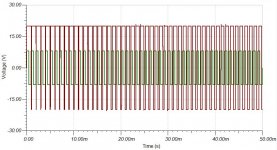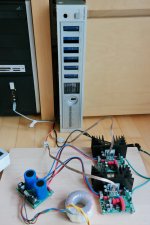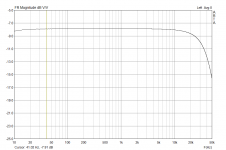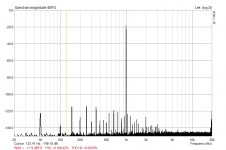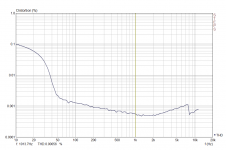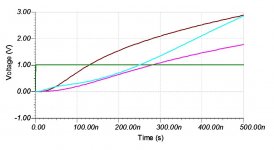For such a speaker the single LM3886 version has no chance anyway... My dipole subs are driven with a 2x250W class-D amp.
Here a simulation with 1uF II 8 Ohm, drived with 1kHz, 2Vp-p square signal.
Have you looked at the clipping behaviour? You can tease out a lot of stuff in simulation if you take the square wave to clipping levels. Do the same with a sine wave. Then repeat in real life... 🙂
Tom
I've simulated it, see the pics with 8Vpp input (1ms pulse and square wave 1kHz). As I wrote befor (#116), in the real world a huge impulse is not a problem anymore (I've revised some component values), with square wave did not tested yet...
Attachments
Last edited:
Cool!!
I highly recommend looking at the clipping behaviour (both in sim and in real life). You'll likely notice many of the LM3886 quirks as the amp just enters clipping. I generally find the amp behaves differently depending on whether you drive it to clipping with a square wave or a sine wave. Square waves tend to push harder on stability for some reason.
That said, as you point out, square waves aren't common in music signal, so maybe testing with square waves is a bit too conservative of an approach.
Tom
I highly recommend looking at the clipping behaviour (both in sim and in real life). You'll likely notice many of the LM3886 quirks as the amp just enters clipping. I generally find the amp behaves differently depending on whether you drive it to clipping with a square wave or a sine wave. Square waves tend to push harder on stability for some reason.
That said, as you point out, square waves aren't common in music signal, so maybe testing with square waves is a bit too conservative of an approach.
Tom
Also look at the THD at 20 Hz. The DC servo can muck things up there if its cutoff frequency is too high (or its filter slope or stop band attenuation is too low).
Bonnie Baker (National Semiconductor now TI) has a great app note about filter design that's worth digging out. Keep in mind that a DC servo is really just a lowpass filter.
Great work so far, though. Thanks for sharing!
Tom
Bonnie Baker (National Semiconductor now TI) has a great app note about filter design that's worth digging out. Keep in mind that a DC servo is really just a lowpass filter.
Great work so far, though. Thanks for sharing!
Tom
Thank you Tom!
The DC low-pass filter won't be an issue I think because of I'll use the servo only in the upper range, for the mid-woofer coupling foil-capacitors (perhaps bipolar). Active systems have some benefits...🙂
/I didn't found the AN from Bonnie Baker... I've used the Duglas Self book/
The DC low-pass filter won't be an issue I think because of I'll use the servo only in the upper range, for the mid-woofer coupling foil-capacitors (perhaps bipolar). Active systems have some benefits...🙂
/I didn't found the AN from Bonnie Baker... I've used the Duglas Self book/
Also look at the THD at 20 Hz. The DC servo can muck things up there if its cutoff frequency is too high (or its filter slope or stop band attenuation is too low).
Bonnie Baker (National Semiconductor now TI) has a great app note about filter design that's worth digging out. Keep in mind that a DC servo is really just a lowpass filter.
Great work so far, though. Thanks for sharing!
Tom
Last edited:
there is also a good chapter or two in 'Op-amps for Everyone' that can be downloaded from the ti.com web site.
How do you mean it kokoriantz?
So, I've made some real test with a good sound card (modified Xonar D2X) and Arta/Step. The result is acceptable I think. The low freq. values (<50Hz) at the THD curve is a measuring issue, I must search for the reasons...
BUT: I've made a drop-in test with my old Toshiba amp and small 3" fullrange speakers. The Toshiba has definitely more noise and distortion, but it is more open and balanced at the top-mid and high freqs. If I should choose I would vote against my composite amp...🙁 It seems that the c-amp has a roll-off in the upper octave and/or has some phase issues. What do you think?
So, I've made some real test with a good sound card (modified Xonar D2X) and Arta/Step. The result is acceptable I think. The low freq. values (<50Hz) at the THD curve is a measuring issue, I must search for the reasons...
BUT: I've made a drop-in test with my old Toshiba amp and small 3" fullrange speakers. The Toshiba has definitely more noise and distortion, but it is more open and balanced at the top-mid and high freqs. If I should choose I would vote against my composite amp...🙁 It seems that the c-amp has a roll-off in the upper octave and/or has some phase issues. What do you think?
Attachments
Last edited:
The amplifier you designed is inteded to be domestic use HIFI audio component . You don't need to undergo tests intended for industrial requirements as 1uf on the output and still have excellent saturation behavior . Maximum capacitance you can have paralleling the output is few hundred of pf due to speaker cable of few meters.
The bad news I can give you , human ears cannot perceive distortion down to 0.1%, and far less distinguish from a sound of a speaker distorting several % . If you optioned to go composit instead of alone standing LM3886 , is to have a better sounding amplifier. So built a quick air mounted LM3886 simple circuit , gain 10 (3 resistors + 2 capacitors) and compare the 2 amps . The alone LM3886 has a blindness of 600ns vs yours you could bring it down to 20ns (I still wonder how you did it) . When you apply a burst of sinosoidal signal at the start of the signal the output goes blind , waiting the integrating capacitors to charge . This provokes same type of distortion as crossover does but only at begining of the burst , unaudible . If the music is made of several voices of about same frequency , the distortion becomes unacceptable . The song "Happy Together" of Turtles needs blindness of less than 300ns to be acceptable when the small choral gives the refrain. The Ironside theme of Quincy Jones is an encyclopedia of sounds . If your blindness is not less than 200ns the music sounds uninteresting ,all willing to lower down the volume . The requiem of Verdi (BBC symphony)needs a blindness of less 50ns to have the several hundred chorists and 70 instruments at full power be reproduced clearly to provoke intense emotions . The "Sing Sing Sing" of B. Goodgman's , where 27 horns blowing , With 50ns or more you get ear piercing disgusting sound . Whereas with 30ns or less you hear a pleasent beat of the multiple horns. Finally the most difficult music to reproduce to my knowledge , the requiem of Mozart (Karayan) needs 20ns to provoke spiritual emotion instead of garbage sound you will hear from alone standing LM3886.
The bad news I can give you , human ears cannot perceive distortion down to 0.1%, and far less distinguish from a sound of a speaker distorting several % . If you optioned to go composit instead of alone standing LM3886 , is to have a better sounding amplifier. So built a quick air mounted LM3886 simple circuit , gain 10 (3 resistors + 2 capacitors) and compare the 2 amps . The alone LM3886 has a blindness of 600ns vs yours you could bring it down to 20ns (I still wonder how you did it) . When you apply a burst of sinosoidal signal at the start of the signal the output goes blind , waiting the integrating capacitors to charge . This provokes same type of distortion as crossover does but only at begining of the burst , unaudible . If the music is made of several voices of about same frequency , the distortion becomes unacceptable . The song "Happy Together" of Turtles needs blindness of less than 300ns to be acceptable when the small choral gives the refrain. The Ironside theme of Quincy Jones is an encyclopedia of sounds . If your blindness is not less than 200ns the music sounds uninteresting ,all willing to lower down the volume . The requiem of Verdi (BBC symphony)needs a blindness of less 50ns to have the several hundred chorists and 70 instruments at full power be reproduced clearly to provoke intense emotions . The "Sing Sing Sing" of B. Goodgman's , where 27 horns blowing , With 50ns or more you get ear piercing disgusting sound . Whereas with 30ns or less you hear a pleasent beat of the multiple horns. Finally the most difficult music to reproduce to my knowledge , the requiem of Mozart (Karayan) needs 20ns to provoke spiritual emotion instead of garbage sound you will hear from alone standing LM3886.
Thank you!! I understand slowly the idea behind the individual compensating components. I took the hard way, experience all myself...🙂
Exactly... But I say it's the hardest challange. I've tryed about 5-6 versions and I clearly could not beat my old discrete amp yet in terms of transparent, airy, stress-free natural presentation in the upper-mid and high range. So, further investigation is strong needed...
(I've made a mono setup with 3" wide-range speakers side-by-side in the same configuration, and switched instantly with a balance pot)
(I've made a mono setup with 3" wide-range speakers side-by-side in the same configuration, and switched instantly with a balance pot)
Last edited:
How about comparing with My_Ref and Modulus, have you done that? And what is your power supply for the opamp, is it good?I clearly could not beat my old discrete amp yet in terms of transparent, airy, stress-free natural presentation in the upper-mid and high range. So, further investigation is strong needed...
PSU see on the pic before, 2x18Vac toroid (30VA for testing), 4x MUR820 diodes and 2x10.000uF/40V Vishay 056 caps. PSU for the opas: LM317/337, +/- 15V, SilmicII 2x47uF output caps, 100nF X7R by the IC packages.
In the signal path C0G or FKP02 caps, thin-film resistors.
No, I do not have Modulus...
I should test perhaps with other speakers too, and my idea is to apply a bandpass filter and comparing the audible differences in the individual frequency ranges...
In the signal path C0G or FKP02 caps, thin-film resistors.
No, I do not have Modulus...
I should test perhaps with other speakers too, and my idea is to apply a bandpass filter and comparing the audible differences in the individual frequency ranges...
Last edited:
I use Super Regulator after the LM317/337 (pre-regulator).PSU for the opas: LM317/337
Styroflex will produce more airy treble.In the signal path C0G or FKP02 caps
That's for apple to apple comparison. I have never heard the Modulus myself but I'm curious as LME47920 (55M) seems too fast for 2-8MHz LM3886.No, I do not have Modulus...
- Home
- Amplifiers
- Chip Amps
- LM3886 & LME49720 composite amp

